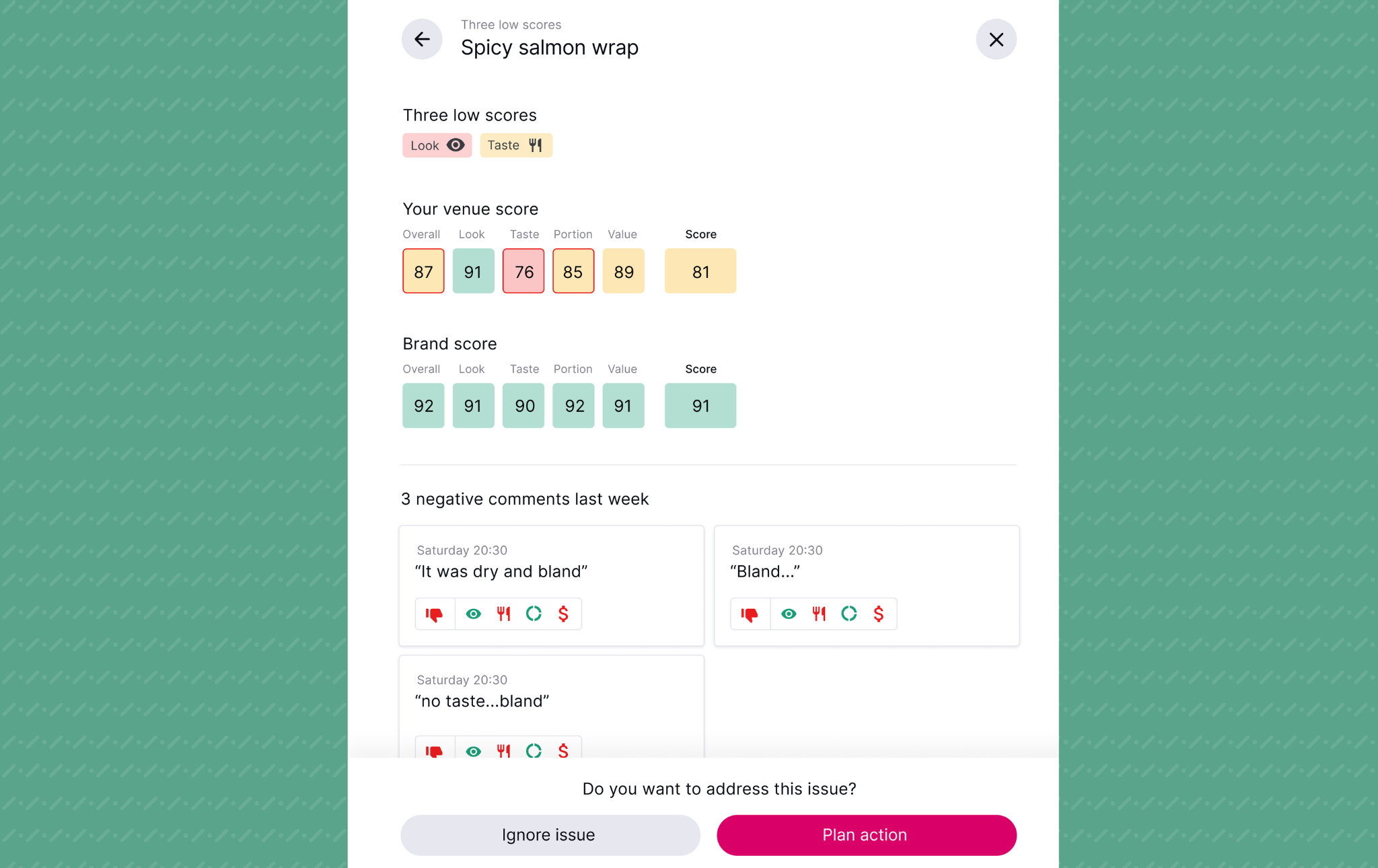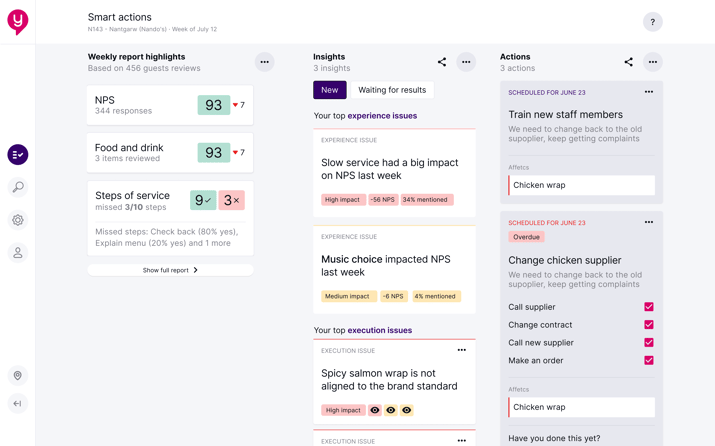How Dish-level Data Can Guide Your Menu Engineering and Pricing Strategy

While the upcoming holidays are meant to be joyful, restaurant workers may find themselves particularly stressed right now.
Collectively, the industry is grappling with the effects of rising food costs, inflation, supply chain instability, and some customers feeling like they’re paying more for less. We’ll talk more about the fallout from customers experiencing “shrinkflation” a little later.
With restaurant leaders hard at work strategizing their winter and fall menus, menu engineering and pricing strategies are top-of-mind challenges right now. And while it’s common practice to make menu pricing changes based solely on sales data or gut feelings, there’s a better, more sustainable way to go about this.
So, how can restaurants manage their margins while keeping customers coming back for more? The answer relies on capturing feedback data at the dish level and uncovering your customers’ value perception of each menu item.
The Power of Dish-level Data and Food Scores
Today’s industry challenges demand innovative and proactive solutions. Food scores provide just that.
These scores are based on customer feedback on the look, taste, portion, and value of each dish. With this granular dish-level feedback, restaurants are able to assess the performance of each menu item, make adjustments to dishes that are underperforming, and track progress over time.
Since food scores are derived from customer satisfaction, they can also be used as a predictor of future sales. Therefore, instead of relying on reactive sales numbers, dish-level data equips restaurant leaders with a valuable tool to make proactive, data-informed menu decisions.

Four Ways Dish-level Data Can Guide Your Menu Engineering Strategy
#1: Track Menu Execution and Make Adjustments
Dish-level data allows you to track the performance of each menu item, so teams can monitor menu execution based on real-time customer satisfaction data and make adjustments as needed.
For example, if your fried chicken sandwich offering is scoring low for “look” and “taste,” adjustments could be made to how the meal is plated and prepared by your BOH team.
Changes could involve adjusting the frying temperature or amount of time it is cooked, modifying the batter recipe, or examining whether the sandwich’s wet ingredients may be impacting how toasted the bread buns keep once served to customers. Nobody likes soggy bread!
Our Smart Actions feature sends general managers a weekly short list of the factors impacting menu performance and the next steps teams can take to improve menu execution, making it easier for GMs to increase food scores.

Smart Actions
#2: Mitigate Risks to Margins and Customer Satisfaction When Testing New Menu Items or Seasonal Menus
It could take months before sales numbers reflect how menu changes affect customer satisfaction and your brand’s margins.
Dish-level data gives you real-time visibility into performance, and within a matter of days, restaurant operators can see how each new menu item or full menu is performing.
This quicker visibility is particularly useful when testing new holiday menus or limited-time menu offerings. Brands can track how customers respond to new menus and pricing ahead of time through A/B testing in certain locations or regions.
This menu engineering method minimizes the risk of rolling out a new menu brand-wide and it not performing well with your customer base.
#3: Make Real-time Changes Back of House (BOH)
It’s inevitable that menus won’t be executed perfectly each and every time, and that’s to be expected. Nobody’s perfect.
Fortunately, real-time dish-level feedback grants BOH teams the ability to make immediate changes to recipes or pull dishes from the menu for the day altogether if they notice a negative pattern in the feedback data.
These real-time changes can go a long way in regards to customer retention, especially when restaurants are bustling during the holiday months.
#4: Assess Your Food Suppliers and Menu Complexity
With food costs skyrocketing, thoroughly assessing your food suppliers could benefit your margins.
Brands may notice that switching to a less expensive product doesn’t affect (or sometimes even increases) customer satisfaction rates of that dish. This is a win-win situation. Your brand saves money and keeps customers happy.
You can also use this data to reduce the complexity of a particular menu item or category. For example, hand-cut, made-from-scratch french fries may not particularly make your customers any happier than frozen or pre-cut french fries.
Reducing complexity usually not only saves restaurants money on the cost of ingredients but also reduces labor costs since less complex recipes require less prep time.
How Uncovering Customers’ Value Perception Can Guide Your Menu Pricing Strategy
While we’ve touched on the importance of customer sentiment around the look and taste of each menu item, when it comes time to price your menu, uncovering your customers’ perception of the value and portion size of each dish can really pay off.
As is the case in menu engineering, there’s a more sustainable way to go about your menu pricing strategy than just looking at your sales data.
Making a blanket price hike across your menu or shrinking portion sizes while also raising prices are examples of what not to do.
Customers have been quick to notice unwelcome changes such as this, such as what’s now been dubbed “shrinkflation.” Shrinkflation occurs when restaurants shrink the portion size of their menu items but keep prices the same or slightly raise them.
It’s rooted in an effort to save margins amidst rising food and labor costs, however, some customers feel like they aren’t getting the same value for their money. As a result, they’re not shying away from letting brands know their displeasure by posting negative reviews online, damaging your brand.
A more effective menu pricing strategy relies on uncovering your customers’ value perception of each dish and then making incremental pricing changes to dishes regarded as highly valuable.
Making slow, incremental price increases over a period of time that customers don’t perceive to be major changes can lead to an increase in revenue for your brand, while simultaneously not affecting customer satisfaction scores.
The key to this pricing strategy is keeping menu price increases under the ‘just noticeable difference range.’
With Yumpingo, you can use the value perception and portion data of each dish in a quantifiable way when making pricing changes.
This dish-level data can easily reveal whether brands should take one of the following routes to increase the profitability of a menu item: 1.) increase the price of the menu item, 2.) decrease the portion size, or 3.) modify the offering to be a part of a combo or set menu.
Further, value perception data at the restaurant level can help inform a pricing tier strategy by market, concept, or region and give insight into the different price sensitivities of customers in different markets.
Instead of making sweeping changes based solely on GDP or competitor pricing, value perception data gives brands the confidence to make data-informed pricing decisions that take into account what their customers deem valuable.
Solving Critical Industry Challenges Through Innovation
Inflation is affecting both customers and restaurant operators alike this festive season.
With tighter budgets, customers are giving more thought to where they choose to spend their money, while restaurants are facing an ongoing battle against rising food and labor costs without a definitive end in sight.
It’s time to break the status quo. While sales numbers provide brands with data on frequently-ordered, “popular dishes” that read well on a menu, there’s no way of determining whether or not your customers are satisfied after ordering these dishes and why.
Further, sales data is a lagging performance indicator and not entirely reliable when tracking menu execution and customer satisfaction.
A restaurant’s top-performing dish could in actuality be making your customers unhappy and contributing to an increase of detractors of your brand, who could potentially dine out at your restaurant less frequently, or sometimes never return.
For this reason, some of the leading restaurant brands are using innovative and sustainable solutions like dish-level data and customer value perception to improve their business.
Our leading restaurant technology platform breaks the status quo and guides brands toward more innovative menu engineering decisions and pricing strategies by capturing valuable dish-level data across all menu items.
Book a free demo below to learn more about how Yumpingo can help you solve the biggest industry challenges.
Share this:
Subscribe to our Newsletter
You May Also Like
These Related Stories

How to deal with difficult customers [+ examples]

Brand experiences for better not worse
